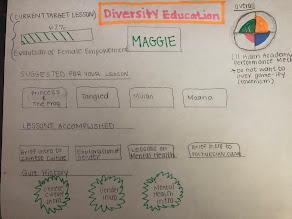Prototyping
Tom Kelley captured an idea that resonated with our team's prototyping process incredibly well. He said, "When the project is
especially complex, prototyping is a way of making progress when the challenges seem insurmountable." Our ideation session was incredibly productive; we identified that we wanted to frame our solution as a Diversity education mode aimed at bettering Disney+'s LPA's Culture-Diversity performance. However, initially, as we started to bridge the ideation and prototyping process, we were overwhelmed with all of the features we wanted to include. As prototyping progressed, we were able to make steady progress in approaching this complex solution while "building to learn".
(Prototype of User Profile; Captures Metrics on Lessons)
Our initial prototype sessions were centralized around creating the foundational framework of our platform. We began to approach visualizing this through the use of Figma, a collaborative interface design tool that would allow us to create a mock Disney+ platform. Professor Luchs guided us to consider whether this was too refined for the stage of prototyping we found ourselves at. Using that suggestion, we completely identified that we were creating a prototype that was too developed and refined. We came to realize that this was a challenge to our productivity in two key ways.
The first challenge of jumping to creating a more polished one at this early stage was that we were still in need of developing a shared vision. Tom Kelley exaggerated the importance of using prototyping as a learning process. We needed to be quick and adaptive when prototyping our Disney+ Diversity Education mode. By launching into a finalized product, we were creating the mindset that we were fully satisfied with our idea and were past the learning point. However, this was not the case. We had to ask ourselves foundational questions that emerged from spontaneous thought processes while prototyping.
The second challenge was creating a finalized product prematurely, inciting reluctance to criticism, both as group members and for the subsequent evaluation process. It should be incremental, which Kelly articulated with the analogy of "Instead of the long ball, try
to get a few yards, passing to the sidelines to stop
the clock." By creating a polished product, we were locking ourselves into a prototype that we may feel guilty altering drastically. It would look amazing from a lot of hard work, and naturally, it is not easy to diminish the amazing work that someone did by suggesting drastic pivots.
Identifying these challenges, we quickly shifted to drawing on paper individually what aspects we thought should be included in our prototype, which you can see below. These rough sketches were incredible starting points because they facilitated dialogue about how they pieced into our culminating solution. Questions like, "When does the consumer see this" and "How does that articulate their progress in learning Diversity lessons in an accessible way" emerged from these rough sketches, which helped us start to visualize the solution in its entirety.
(Prototype of User Profile; Captures Metrics on Lessons)
(Prototype of Media Thumbnail; Performance/Information)
We utilized these sketches to start to create a mock consumer experience. We realized we had the building blocks, but we now needed to organize them to have a cohesive workflow. This organization time, I believe, was one of the strongest dialogues we had had as a group. We asked tough questions to each other, aiming to refine how meaningful and accessible our platform would become. I strongly attribute this openness to asking the tough questions to the un-polished state of our sketches. We were much more ready to challenge a quickly pencil-sketched drawing than we would have been with a polished digital platform.
All in all, this was an incredibly productive and open prototyping session. Tom Kelley could not be more write at how educational prototyping is to the designers. This period was incredibly productive, and I am very excited to keep this learning mentality around for our evaluation process with another group next Tuesday.




Comments
Post a Comment